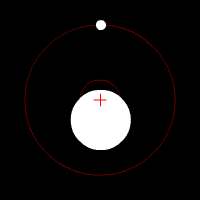At one quarter the mass of the Earth, the newly-discovered planet is not only one of the closest planets we know of, but also one of the lightest. The planet is named Proxima d.

Hey planet, here’s an ESPRESSO
In 1915, the Scottish astronomer Robert Innes discovered a new star. He called it Proxima Centauri (or rather, Proxima Centaurus).
Proxima Centauri is the closest star to Earth, lying just over four light-years away — and will continue to be so for about 25,000 years, after which Alpha Centauri A and Alpha Centauri B will move closer to our solar system and will take alternating turns as the “closest star to Earth” (for about 80 years each).
But it took another hundred years after the star was named for the first planet in the Proxima Centauri solar system to be discovered. Astronomers are nothing if not methodical, so in 2016, when they discovered a planet, they called it Proxima b. They found another planet candidate in 2019 which they called Proxima c. Now, they’ve discovered a new planet and named it (you’ve guessed it) Proxima d.
“The discovery shows that our closest stellar neighbor seems to be packed with interesting new worlds, within reach of further study and future exploration,” explains João Faria, a researcher at the Instituto de Astrofísica e Ciências do Espaço, Portugal and lead author of the study published today in Astronomy & Astrophysics.
The planet was first discovered in 2020, and was now confirmed with the Echelle SPectrograph for Rocky Exoplanets and Stable Spectroscopic Observations (ESPRESSO).
“After obtaining new observations, we were able to confirm this signal as a new planet candidate,” Faria says. “I was excited by the challenge of detecting such a small signal and, by doing so, discovering an exoplanet so close to Earth.”
The planet was discovered using a less common method. Because planets don’t emit their own light, researchers rely on indirect information to find them. Most commonly, they use a method called the transit method — basically, they measure the luminosity coming from a star and look for dips in luminosity caused by planets passing in front of that star. But Proxima d was discovered using the radial velocity technique.
The technique works by detecting tiny wobbles in the motion of the star — wobbles created by a planet’s gravitational pull. With this, they can not only detect the presence of a star but also calculate its mass.

“This achievement is extremely important,” says Pedro Figueira, ESPRESSO instrument scientist at ESO in Chile. “It shows that the radial velocity technique has the potential to unveil a population of light planets, like our own, that are expected to be the most abundant in our galaxy and that can potentially host life as we know it.”
“This result clearly shows what ESPRESSO is capable of and makes me wonder about what it will be able to find in the future,” Faria adds.
The gravitational effect of Proxima d is pretty small — it only causes Proxima Centauri to wobble by around 40 centimeters per second (1.44 km/hour) — and it’s striking that astronomers can detect these small differences from 4 light-years away. Based on this, researchers calculated that the planet is around one-quarter the mass of the Earth and one of the lightest exoplanets ever found.

The planet does not lie in the habitable zone. Although the star is a red dwarf star with a mass around 8 times lower than that of the Sun, the planet simply orbits the star too closely. Assuming an Earth-like reflectivity of the planet, the surface temperature would be 87 °C (188 °F) — too hot to support life as we know it. Another Proxima Centauri planet (Proxima b) could lie in the habitable zone, but this is still disputed by astronomers.
Researchers expect more intriguing data to come from ESPRESSO’s search for other worlds, especially as it will soon be complemented by ESO’s Extremely Large Telescope (ELT), currently under construction in the Atacama Desert. Together, these two will enable researchers to discover and study many more planets around nearby stars.
The study was published in the journal Astronomy and Astrophysics.


